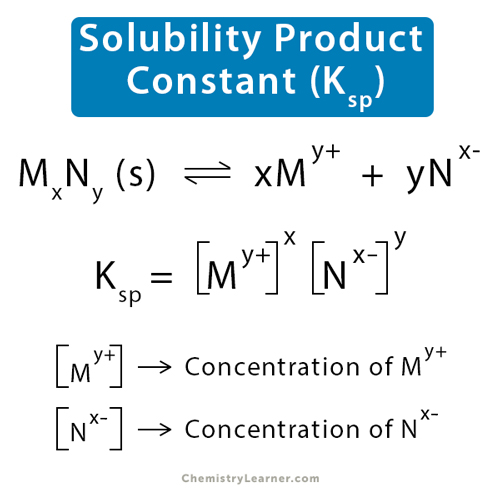Solubility Product Constant (Ksp)
The solubility product constant, or Ksp, is the equilibrium constant of a solute dissolving in a solvent to form a solution. A solute is soluble if more than 1 g dissolves in 100 mL of water. The solubility product constant is generally used for a sparingly soluble solute that does not entirely dissolve. It represents the extent to which the solute can go into the solution. The more soluble a solute, the higher the Ksp value [1-4].
How to Find Solubility Product Constant
When a soluble ionic compound is added to water, it disassociates into its constituent ions and goes into the solution. There is an equilibrium between the undissociated solid compound and the ionic solution. The general dissolution of a substance MxNy is given below [1-4].
MxNy (s) ⇋ xMy+ (aq.) + yNx- (aq.)
The following equation gives the solubility product constant.
Ksp = [My+]x [Nx-]y
To solve for Ksp, one must raise the concentrations of the products to their stoichiometric coefficients and multiply them. The solid reactant MxNy is not included in the expression. The reason is that its concentration does not change during the reaction. Hence, Ksp denotes the maximum extent that a solid can dissolve in a solution.
Since it is the product of the ion concentrations present in a saturated solution of an ionic compound, Ksp is called the solubility product constant.
Example
Consider the dissolution of calcium phosphate (Ca3(PO4)2)
Ca3(PO4)2 (s) ⇋ 3 Ca2+ (aq.) + 2 PO43- (aq.)
The solubility product constant for the dissolution of (Ca3(PO4)2 is
Ksp = [Ca2+]3 [PO43-]2
The value of Ksp at 25 ˚C for a pH of 7.0 is 2.07 x 10-33. It means that the concentrations of Ca2+ and PO43- ions in equilibrium with Ca3(PO4)2 are extremely low.
The Ksp values for some common salts at 25 ˚C are listed in the table below.
| Solid | Formula | Ksp |
|---|---|---|
| Silver bromide | AgBr | 5.35 x 10-13 |
| Calcium carbonate | CaCO3 | 3.36 x 10-9 |
| Lead carbonate | PbCO3 | 7.40 x 10-14 |
| Silver chloride | AgCl | 1.77 x 10-10 |
| Lead chloride | PbCl2 | 1.70 x 10-5 |
| Calcium chromate | CaCrO4 | 7.40 x 10-4 |
| Barium fluoride | BaF2 | 1.84 x 10-7 |
| Calcium hydroxide | Ca(OH)2 | 5.02 x 10-6 |
| Lead iodide | PbI2 | 9.80 x 10-9 |
| Silver phosphate | Ag3PO4 | 8.89 x 10-17 |
| Barium sulfate | BaSO4 | 1.08 x 10-10 |
| Silver sulfate | Ag2SO4 | 1.20 x 10-5 |
| Cadmium sulfide | CdS | 8.00 x 10-27 |
| Lead sulfide | PbS | 8.00 x 10-28 |
Problems and Solutions
Problem 1: Calcium fluoride (CaF2) is slightly soluble in water and dissolves as follows:
CaF2 (s) ⇋ Ca2+ (aq.) + 2 F– (aq.)
The concentration of Ca2+ in a saturated solution of CaF2 is 1.5 × 10–4 M. What is the solubility product constant of CaF2?
Solution
Given
[Ca2+] = 1.5 × 10–4 M
The number of moles of fluoride (F–) is twice that of calcium. Therefore,
[F–] = 2 x 1.5 × 10–4 M = 3 x 10-4 M
The following equation gives the solubility product constant (Ksp):
Ksp = [Ca2+] [F–]2
=> Ksp = (1.5 × 10–4 ) (3 x 10-4)2
=> Ksp = 1.35 × 10-11
We do not include the units for Ksp.
How to Calculate Molar Solubility from Ksp
To understand how to calculate molar solubility from Ksp, let us take an example of silver sulfate (Ag2SO4).
Problem 2. Ag2SO4 has a Ksp value of 1.20 x 10-5 at 25 ˚C. The dissociation of Ag2SO4 is given by
Ag2SO4 (s) ⇋ 2 Ag+ (aq.) + SO42- (aq.)
Calculate the molar solubilities of Ag+ and SO42-.
Solution.
Given
Ksp = 1.20 x 10-5
The dissociation equation is given by
Ksp = [Ag+]2 [SO42-]
Let x be the number of moles of SO42-. Then, the number of moles of Ag+ is 2x. Let us plug in the value of Ksp to get an algebraic expression.
1.20 x 10-5 = (2x)2 (x)
=> 1.20 x 10-5 = 4x3
=> x3 = (1.2 x 10-5)/4
=> x = 0.014
Therefore,
[SO42-] = 0.014 M and [Ag+] = 2 x 0.014 = 0.028 M
Factors Affecting Solubility Product Constant
1. Temperature
Most solutes become soluble with an increase in temperature. An example is coffee dissolving more quickly in hot water than in cold water. Temperature affects the solubility of solids and gases, but not liquids.
2. Pressure
Pressure affects the solubility of gases in liquids. According to Henry’s law, the solubility of gases is directly proportional to the partial pressure. The solubility increases if the partial pressure increases and vice versa.
3. Molecular Size
Solutes having smaller molecular sizes are more soluble than ones with larger sizes. So, those molecules can dissolve faster than larger molecules.
